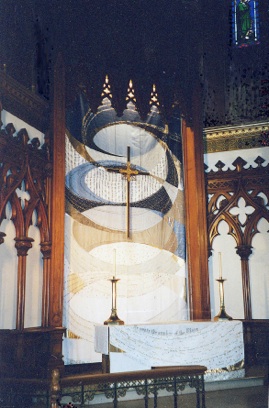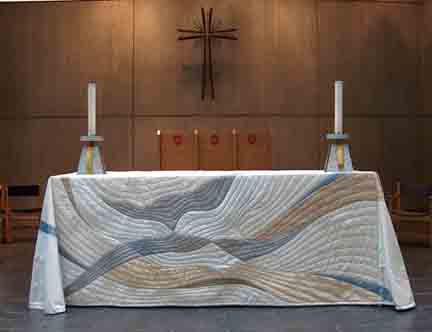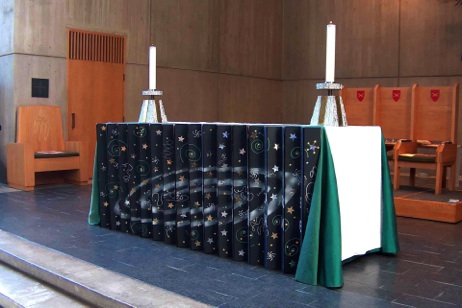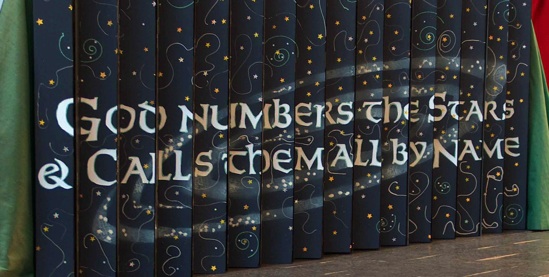






The term ‘Frontal’ would seem to imply that the object in question is placed on the front of some-thing and while some frontals hang on the on the front of the altar only, others cover the front and sides and still others come to the floor on all four sides of the altar and are known as Jacobean, Laudian or Throw-Over (!) Frontals. A frontal that does not reach the floor is a Super-Frontal. There are sure to be more nuances of terms used for this wonderful piece of Liturgical Art ‘real-estate’ but the obvious weight of it’s importance is certain. Yet, there are times, places and circumstances when it needs to be omitted, letting the Fair Linen carry the day.
The frontals in both photos above were designed as a ‘continuation’ of the dossal. Their use has been discontinued as they have come to be viewed as ‘over-kill’. Since the altar itself is quite handsome, complementing the other carved wood in color and ornament - and the lower portions of the dossal visible through it - I think it is an appropriate change.
The Jacobean frontal on the altar in this very spare, contemporary Chancel plays against the strictly geometric lines surrounding it. The softness of the curves, the nuanced color palette and the quilting all create an appropriate focus for a fairly large, naturally-lighted worship space. Other pieces in this ‘Festive White’ array can be seen in sections under Chasubles, Copes & Mitres, along with a discussion of the design details.


An Acolyte Workshop provided the opportunity to create this unusual ‘celestial’ frontal which was placed over the existing one for the occasion. Read more about this interesting project in ‘Collaborations’. Everyone liked it so much it was trotted out for all to see during Diocesan Convention. ‘Unique’ sometimes becomes very powerful - as does the opportunity to help create it.
+ + + + + + + + + + + + + + + + + + + + + + + + + +

Workshop Frontal - left

Workshop Frontal - centered
+ + + + + + + + + + + + + + + + + + + + + + + + + +

While the traditional color for Palm Sunday is red, the green palm images are what come to most people's minds when speaking about this Holy Day. What we carry home is most often a small portion of a leaf that is mighty indeed, spanning more than three feet! But the important visualizing of Palm Sunday is the movement of the palms, whether being waved as Christ passes by or being placed on the pathway, symbolizing peace and acknowledging the kingship of the Son of God.
The palm leaf on this frontal is large, its curving form conveying a sense of motion from the moment worshippers enter the church. It varies in color so as to give a sense of depth and space. The fact that the green of the leaf-form is a color-compliment to the red background causes the palm image to shimmer against the red - a subtile sense of movement.
This frontal is made of dupioni silks, characterized by their peculiar characteristic of being woven from two often widely varying colors; this results in the distinctive changes in color as the viewer approaches. In relating to the 'procession' of Palm Sunday, the fabrics themselves seem to celebrate the entry of Christ into our midst.
+ + + + + + + + + + + + + + + + + + + + + + + + + +



I created the new red vestments and frontal to the Glory of God and in loving memory of my late husband, Charles McManis. Charles spent his entire life (from high-school years forward) as a builder of Pipe Organs. I had been collecting red silks for several years in anticipation of this project; last fall the 'key' fabric was found (the plaid) and ideas followed quickly after.
To honor both Charles and the unique worship space that is St. Paul's, the plaid spoke loud and clear. The strong, geometric character is obvious when relating to the building but also acknowledges the 'structure' of the physics of sound - central to the passion of organbuilders, and certainly of Charles' lifetime of work in this field. But sound has many subtle aspects, those unperceived but emotionally present overtones (called 'partials' in the organbuilding business) that affect how we respond to organ tone when it is part of our worship experience.
The coming of the Holy Spirit at Pentecost is both a personal and community event. In some ways unseen and in other aspects very 'in-your-face', the Holy Spirit challenges physical portrayal, just as the overtones of sound defy definition but affect us profoundly. So where is the Holy Spirit in the design of these vestments and frontal? The fabrics chosen are known as 'dupioni' because they are woven in such a way that, as they move in the light (particularly the bright natural light at St. Paul's, a joy in itself) they change and flow, appearing flame-like in their motion. They are the un-logical, emotional aspect of our perception of God-with-us.
Charles' organ designs always acknowledged the power of the Holy Spirit in their deliberate and skillful inclusion of the 'hidden-but-obvious' characteristics of sound. These vestments and frontal evoke the images of Pentecost in the subtle motion within the fabrics. Not so subtle is the inclusion of sparkly 'eyelash' fabric; like the flame that can no longer be contained, the Holy Spirit is in the world, powerful and obvious for those who see.




Special Note: The frontal of this set is identical back and front, acknowledging the frequent practice of celebrating the Eucharist ‘in-the-round’ at St. Paul’s. Everyone is ‘at the front of the bus’ as it were.